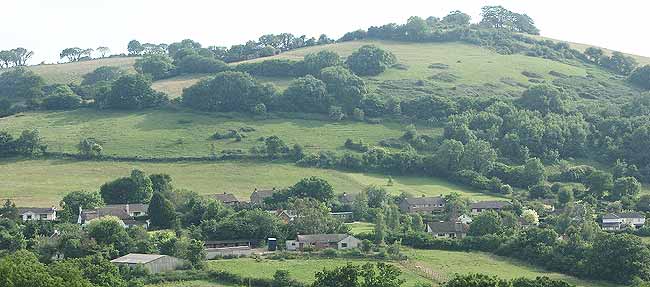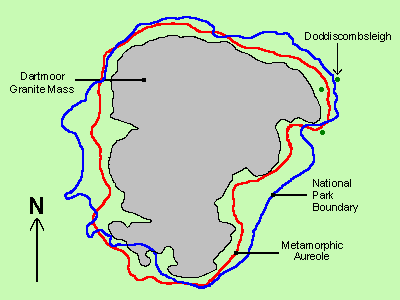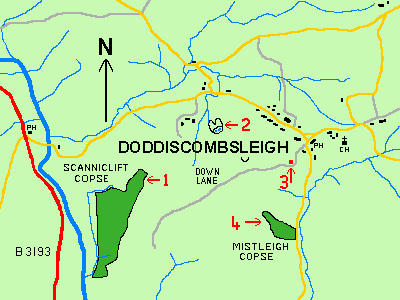Manganese Mining
In Doddiscombsleigh
By Andrew Westcott

Home Page Amateur Radio Concert Master Coxparo Gin Traps Grimspound Rust Electrolysis National Explosives Solar Hot Water Wistmans Wood Doddi Mines Rants Dog Walker Zombies! JS Email Telephone Intercom Whetstone Mining
Index Of Sub-pages:
1: Adits In Scanniclift Copse: Teign Mine
2: Lake Farm Quarry
3: An Exploratory Adit Up Down Lane
4: Exploratory Workings In Mistleigh Copse
Introduction To Doddiscombsleigh And Its Mines
Doddiscombsleigh, occasionally spelt Doddiscombesleigh, is a small village located roughly six miles South-West of Exeter in the county of Devon, England and just one mile East of the River Teign and the Teign Valley. Doddiscombesleigh is within sight of the Haldon Belvedere tower which can be clearly seen on the Haldon ridge and the village is well known locally for its pub, the Nobody Inn and its church of Saint Michael.
I was born in this village and lived here for around the first 25 years of my life. It was partly because my parents owned a farm in the village that I was able to explore the fields and woodlands around Doddiscombesleigh with my friends and it was on some of these 'expeditions' that I first became aware of the evidence of early mining activities in and around the village, some on our property.
It seemed nobody knew anything about the origins of these old mines, although the existence of "The Caves" in Scanniclift Copse was well known amongst the local kids and I was prohibited by my parents from visiting the possibly dangerous old workings, so I did anyway. As is so often the case with childhood fascinations, my interest in these workings has stayed with me.
Manganese As A Product
Manganese ore can occur as a result of various mechanisms; it can occur as a primary deposit, meaning that the mineral was deposited directly from the magma body into fissures in the surrounding rock. It can also occur as secondary deposits, which is where the ore was deposited as a sediment due to erosion of a primary deposit located elsewhere. Manganese may also be present in ancient maritime sediments in the form of polymetallic nodules and the metal can account for up to 25% of the volume of these nodules. Such nodules still occur on the ocean floor nowadays, but is generally not commercially viable to recover them.
Manganese is a highly reactive metal with the chemical symbol 'Mn', an atomic Number of 25 and a specific gravity of 7.43 with physical properties which resemble iron, although it is harder and more brittle. It has many uses, although originally it was used in the glass making industry where manganese dioxide was added to the molten glass to improve its clarity by removing the green colour imparted to it by various iron compounds, although in modern times it is mainly used in the steel making industry where it is alloyed with iron to produce a superior quality of steel, this accounting for over 90% of worldwide consumption, although it also finds use as a depolariser in zinc-carbon dry cells in the form of manganese dioxide.
A Brief Geology Of The Teign Valley

Diagram 1
Doddiscombsleigh in relation to the metamorphosed region
The village of Doddiscombesleigh, geologically speaking, is placed on the outer perimeter of what is known as the 'metamorphic aureole' surrounding Dartmoor, this being the region of rock which was altered by the heat of the neighbouring intrusive magma mass, which eventually cooled and solidified. This large body of granite eventually became exposed after hundreds of millions of years of erosion, producing Dartmoor as we know it today.
The map in diagram 1 shows Dartmoor represented by the grey area, and the approximate line of the metamorphic aureole shown as a red line.
Ore bearing lodes were formed in this metamorphosed region by the action of fluids, principally water under high pressure and temperature, carrying dissolved minerals from the magma into cracks and fissures in the surrounding rock where they were deposited. As a temperature gradient existed through these rocks, different minerals became deposited in the rock according to the distance they were from the magma body with, for example, tin being deposited at high temperatures in or next to the granite, a little further out copper would be found, with manganese being deposited at the lower temperature outer edges of the aureole.

Diagram 2
Mining activity, and the page dealing with it
The stretch of the Teign Valley between the villages of Dunsford and Chudleigh sits right on the metamorphic aureole surrounding Dartmoor and as there is a fault running along the length of this part of the valley, the region has become heavily mineralised and the area is well known for its historic mining activities which exploited the metalliferous ores to be found here. Some of these workings are well known, for example micaceous haematite was mined right up until about 1969 at Great Rock Mines near Hennock, and lead was once mined at Frank Mills Mine and Wheal Exmouth near Ashton. Barytes (Barite) was mined at Bridford Mines up until 1958.
These are the major enterprises but there were many smaller scale ones as well, and although most of these larger workings are well researched and documented, there is little or no mention of the small scale mines in the area, and the manganese workings in and around Doddiscombsleigh are no exception. Diagram 2 shows the parish of Doddiscombsleigh, along with the areas I'm attempting to study. The rock in this village consists predominantly of shale, although there is a dolerite pluton which outcrops near the top of the hill overlooking the village, and this has been quarried on a small scale for the hard stone in years past, leaving a small but visible quarry high up on the hillside.
In the South-West of England the main producer of manganese ore was initially the mine at Upton Pyne which commenced production in 1770, although the deposits there were gradually worked out and the mine closed in 1823, and from about 1812 onwards the main production was coming from mines in Tavistock and the Teign Valley in Devon, which presumably involves the mines being investigated here although there are more manganese workings near the village of Ashton, although again they are of small scale.
Related Links
Teign Valley History Centre
A group formed to preserve the cultural and historical heritage of the Teign Valley.
The metalliferous mining region of south-west England
Includes a small bit about mining in Doddicombsleigh by H. G. Dines
Doddiscombsleigh Village
A community page for Doddiscombsleigh
I can be contacted at this address:
Copyright © Andrew Westcott 2003 - 2024
I'm happy for anyone to use this material for private, non-commercial or educational purposes, but credit to the author must be given. For any other use please contact me for permission.